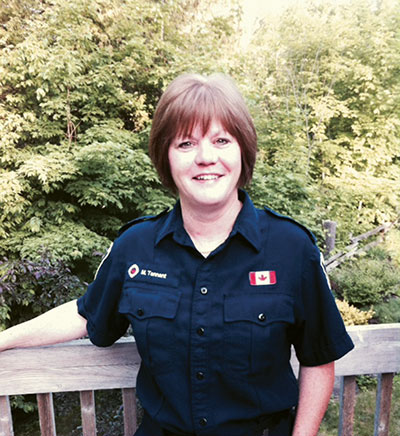
Fully Engaged: July 2014
By Margo Tennant
Features Hot Topics PreventionHow do we help every member of the fire service educate the public about fire safety?
How do we help every member of the fire service educate the public about fire safety? Ontario Fire Marshal and Chief of Emergency Management Ted Wieclawek asked this question at the 21st annual Fire and Life Safety Educators’ conference in Sudbury in October 2013. Words like these inspire me every day to become a better public educator.
My journey began in 2003 when the fire chief of the composite department where I worked as an administrator asked me about my future goals in the fire service. The answer was easy for me: education and more education. I wanted to contribute to the safety of my community. I was given the opportunity to see my goals start to come to fruition when I started to assist our department’s education officer by preparing handouts for school visits, setting up fire safety displays in department stores, and teaching ropes and knots and cooking safety at summer camps for junior firefighters. I was encouraged to take the public fire and life safety educators certification at the Ontario Fire College. By the end of 2006, I had completed the course and was thrilled to join the ranks of other public fire and life educators in Ontario. My ability to reach and teach the public changed dramatically in 2012 when I applied for, and was hired by a career department – Brampton Fire and Emergency Services.
This position provides wonderful opportunities to educate residents to be responsible for fire safety in their own homes. However, we all know that reaching certain groups is extremely challenging. In Brampton, a growing, diverse community like many other Canadian towns and cities, communicating with new Canadians and those whose first language is one other than English is something we think about every day.
As public educators, we cannot stress enough the importance of smoke alarms and escape planning, ensuring that people understand that homes burn eight times faster than they did 30 years ago. We have all encountered situations in which people have experienced small fires in their homes and their first reaction is to try extinguish them – and they believe they can. Occupants attempt to put out fires using extinguishers or garden hoses, but the modern, synthetic materials burn so quickly that the fire fight becomes a losing battle. We know that in the 1980s residents may have had up to 15 minutes to evacuate, considerably longer than they do now – clearly, in many cases, they don’t understand.
So, how do we use the myriad tools at our disposal to get across our fire-safety messages to the right people? Do seniors use social media? A Pew Internet Research Project in 2013 found that in the United States, 65 per cent of people between 50 and 64 use social media and 46 per cent of those 64 and older do so. But how do we target those people? Do they use Twitter? What Internet sites do they visit? How do we reach attention-span challenged university students? How do we explain mandatory CO alarms to new Canadians? What is your department doing to make sure families in your communities have home-escape plans? Let’s share our best practices through this column so we can all put proven ideas to work.
We all have the same internal challenges too: budgets, staff cuts and time. Forming partnerships with external agencies with similar interests in the community such as school boards, seniors groups and public health departments help us reach
more people.
Brampton has a population of more than 500,000; 47 per cent of residents are new immigrants. Sparky and Stop, Drop and Roll work brilliantly with elementary school students. But we need to communicate those messages in languages that parents can understand. By working with some of the diverse groups in Brampton we have delivered presentations aided by translators. We distribute fire-safety pamphlets in a variety of languages in libraries, some fire stations and at city hall.
Culture is another big challenge in our city. Women make up more than half of the population of Brampton, but some cultures are uncomfortable with female family members speaking to authority figures, including firefighters. Removing barriers by being visible in the community and attending multicultural events promotes good public
relations.
Here in Ontario, education had been mandated by the fire marshal as the first line of defence against fire fatalities. There have been more fire deaths in Ontario to this point in 2013 than there were in 2012. It appears that the most vulnerable are those 65 and over. We know that learning is for life and that if we get the right messages to the right people in the right formats, the lessons will have meaning. Everyone wears seatbelts, right?
As American musician B.B. King famously said, “The beautiful thing about learning is that no one can take it away from you.” It’s our job, as public educators, to teach the lessons. But we need help.
And that’s why it’s crucial that we involve all firefighters – not just public education officers – in this quest to prevent fires and save lives. We need to create partnership with firefighters in our own departments to deliver consistent fire-safety messages. What are your department’s strategies for doing that? Next time, I’ll share my department’s philosophy for making everyone a public-educator.
 |
|
Margo Tennant is a fire and life-safety education officer with Brampton Fire and Emergency Services in Ontario. Contact her at margo.tennant@brampton.ca
Print this page